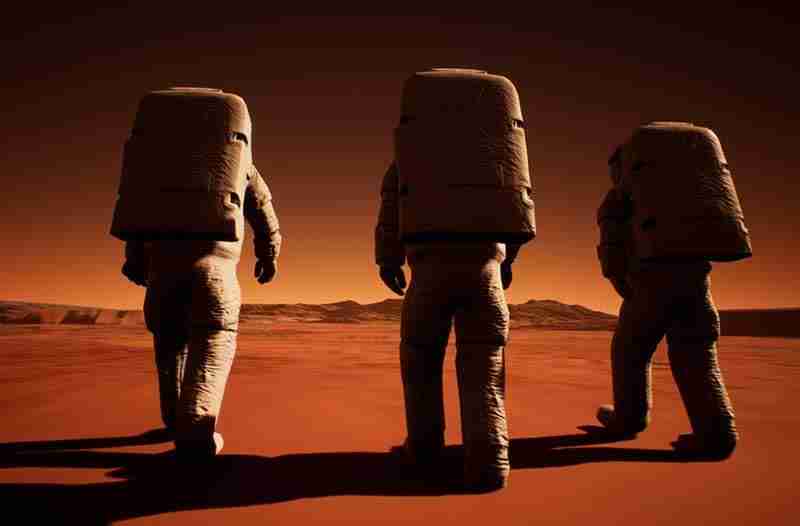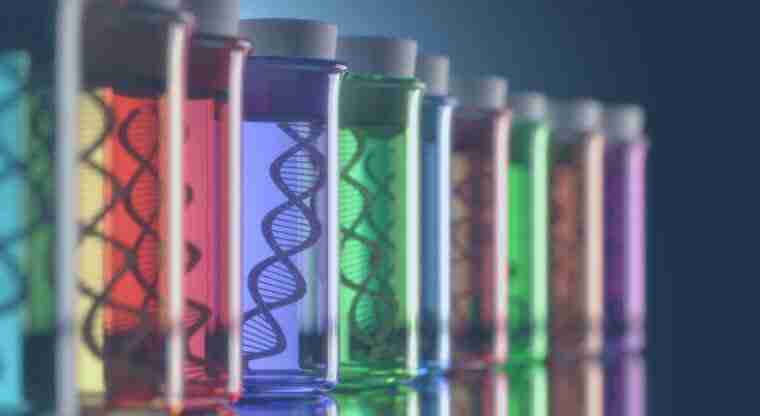Space exploration has long been a source of fascination. Since the stars first captured our attention, we have obsessed over that vast curtain of darkness that lies beyond our atmosphere. But to what end? What ultimate goal does mankind strive towards, if not the ability to visit and colonize other worlds?
Before we can take our first steps out into the universe, we have to answer a critical question: Do we have the ability to adapt to other environments — very different from what we have on Earth — to not only survive, but to thrive? Instead of focusing on how we might terraform other planets to suit us, perhaps we should consider how we might use genetic engineering to alter own bodies to suit those other planets.
As a jumping off point, let’s consider the feasibility of using the popular gene-editing tool CRISPR to alter human physiology to tolerate parameters outside of Earth’s norms. If we take a look at common factors that are significant to human health, gleaned from our experience with space exploration, the most obvious choices for our attention are variations in gravity, atmospheric pressure and gas ratios, and solar radiation levels.
If we consider Mars as our template, because of its relative suitability for colonization, then we must compensate for two-thirds less gravity than Earth. A lack of gravity results in a number of ill effects on human health, including a decrease in bone mass and density over time, particularly in the large bones of the lower extremities, as well as the spine. While we do not have research showing the impact of living on a planet with one-third Earth’s gravity, we do know that we can expect losses in bone density somewhere under 1-2 percent per month, the amount lost in the microgravity environment of space.
For comparison, the elderly lose 1-1.5 percent per month in Earth gravity. Atmospheric pressure that is either too high or too low also results in complications; low atmospheric pressure results in less oxygen available and causes altitude sickness and possible death. Radiation levels from the sun are another variable that is well known to have upper and lower thresholds for optimal human health, where low levels can lead to vitamin D deficiency and high levels increase cell death and cancer.
It would stand to reason that the human body has a minimum threshold for healthy physiology as regards the environment in which it grows, develops and lives. To colonize other planets successfully, we must consider solutions to overcome these thresholds; for example: prostheses, domed colonies recreating an ideal or near ideal environment, or, as this author suggests, the permanent genetic alteration of humanity as a species. This applies to our four chosen variables of gravitational forces, atmospheric pressure, atmospheric gas ratios, and solar radiation levels. While science fiction might have us consider surgical and biomedical prostheses or the more far-fetched use of animal DNA to change ourselves for this purpose, the key to human adaptation for other planets lies in our own genetics and it may well be CRISPR, the use of the enzyme Cas9 for introduction of altered DNA sequences or CRISPRs to existing cells to change how those cells function, that will make this possible.
Human genetic variation provides a veritable treasure trove of adaptations if one looks at the less common but heritable variations that on Earth may seem irrelevant, nonessential, or even maladaptive, but on another planet could be essential to survival. One example of a gene that, with engineering, could help humanity adapt to higher or lower gravity is the LRP5 gene. Recent research into the LRP5 gene shows that mutations of the gene are responsible for both low bone density and elevated bone density in the case of the later, from increased bone formation. A family of individuals in Nebraska carrying the mutation for elevated bone density have never experienced broken bones even well into old age. A whole colony of such individuals or ones engineered to enhance this mutation further could be expected to fare much better during prolonged space travel in zero gravity as well as in the low gravity environment on a planet like Mars.
While an atmospheric pressure and gas makeup very similar to Earth’s would be required for humans to survive and thrive outside of a spacesuit, Nepal’s Sherpas, high altitude dwellers in Ethiopia, and the Collas people in the Central Andes , as well as the deep sea divers of Bajau, may provide a solution to living on planets with differences in atmospheric pressure and oxygen availability. The three groups of high-altitude dwellers appear to have separate adaptations for thriving in low oxygen environments. Recent research indicates that there are genetic mutations in each of these groups. Sherpas’ mutations allow for more efficient use of available oxygen and resistance to ill effects from hypoxia.
Sherpas experience less of an increase in red blood cells than others and therefore avoid the ill-effects caused, such as edema and brain swelling. Sherpa’s instead have mitochondria in their cells that make more efficient use of the available oxygen, as well as having more efficient anaerobic metabolism in the absence of oxygen. The Collas show genetic differences in genes that control heart morphology, as well as cerebral vascular flow, as a means to withstand an elevated hematocrit in response to high altitude living. The Amhara people living in high altitudes in Ethiopia unlike the Sherpas do have lower oxygen saturation and higher hemoglobin levels compared to lowland dwellers in the region.
Research has yet to determine what adaptation favors the Amhara, but several genes that may play a role have been isolated. Another group, the Bajau of Thailand, may have complementary genetic variations that help them resist hypoxia and survive the high pressures of deep sea diving. Researchers found them to have 50% larger spleens and also a gene, PDE10A, that controls a thyroid hormone thought to affect spleen size. Capitalizing on any of these genetic features would improve our ability to survive with a lower oxygen content atmosphere, perhaps on a newly terraformed Mars or under domes with oxygen rationing.
While we cannot yet determine how comparable an atmosphere we can create on Mars, it stands to reason that achieving an exact replica atmosphere to Earth’s could be difficult. An atmosphere that lets in less radiation could impede our production of vitamin D, while a thinner atmosphere would admit an excess of radiation. Vitamin D deficiency could perhaps be handled by supplementation, or instead addressed by increasing our cells response to ultraviolet light to increase vitamin D synthesis. On the other side of the coin, a thinner atmosphere opens us up to higher UVR, which would result in higher rates of skin cancer.
It would stand to reason that, while skin pigmentation has high cultural and historical significance, it could make our species more suitable for colonization of high radiation planets; darker skin with larger melanocytes that react proactively to UVA and UVB radiation through tanning and higher antioxidant and free-radical counteraction would be protective and provide an advantage if we are to branch out into our solar system and beyond. At the same time, this solution poses the problem of vitamin D production.
The answer could lie in isolating and using the genes responsible for East Asian populations’ lower skin pigmentation coupled with lower skin cancer rates than European populations. A study headed by Pennsylvania university has isolated gene mutations responsible for skin pigmentation differences, SLC24A5, MFSD12, OCA2, and HERC2, by studying African, South Asian Indian, and Australo-Melanesian populations, some of which are associated with vitiligo and a form of albinism common in African populations. These mutations that confer higher vitamin D production to Europeans are not present in East Asians, indicating a different mutation responsible, and, while both populations have higher vitamin D production than African populations, Europeans have a 10-20 percent higher rate of cancer than both Africans and East Asians. Further research into these genes could provide targets for CRISPR to modify the protective factors in our skin without sacrificing vitamin D production of potential colonists.
The question remains: is CRISPR a feasible route to including some of these adaptations to create a new, more suitable colonist? To answer this question we look at the current status of CRISPR research.
While some experiments using CRISPR gene editing were conducted in the technology’s infancy, including the controversial creation of twin girls in China designed to be resistant to HIV, we are still quite a bit of research away from using CRISPR with high success rates and full confidence, especially considering the repercussions of rushing into human trials, including the death of trial participants and long-term side-effects of cancer, both of which have occurred in gene-therapy trials.
According to information revealed by the FDA and NIH, 691 trial volunteers died in gene-editing trials prior to the tragic and high-profile death of Jesse Gelsinger in a 1999 trial to treat his OTCD, a rare metabolic disorder. The death was blamed on ethical oversights and a rush to make gene editing pan out before it was ready. The result was a long period of gene-editing fear and oversight but also, in the case of James Wilson, director of the University of Pennsylvania’s Institute for Human Gene Therapy responsible for the trials that led to Gelsinger’s death, greater caution in research methodology. He has put safety at the forefront of his research and asserts that even still the risks of gene editing with CRISPR and other methods brings enough risk to justify human trials only for those diseases that are severe and debilitating enough for patients to accept the risks of gene editing.
What does all this mean for our hypothetical future of using CRISPR to edit the DNA of human colonists for space colonization? Is the technology too far off to serve our purpose or fraught with too much risk? Is it beyond our knowledge and skill to accomplish? The answer to each of these questions is undoubtedly, no.
We’ve had too much success in treating complex genetic conditions, like the creation of an immune system for Ashanthi Desilva born with severe combined immunodeficiency (SCVID). We’ve unlocked too many keys to making gene therapy safer and more effective to discount the possibility of future use for the advancement of our species into harsher environments. While subsequent uses of gene therapy for SCVID resulted in development of Leukemia years later, further advancements in the research have revealed the need to find the best delivery system for each body system. Adeno-associated viruses, and lentiviruses are being looked at in place of the more aggressive adenovirus or retroviruses for delivery of DNA segments both of which are less likely to provoke an immune response and less likely to trigger cell death by way of the B35 gene in healthy cells, and later cancer.
Regardless of the work ahead and the bumpy road that gene therapy has traveled, vast potential remains at our fingertips whether it is through use of CRISPR or future gene therapy tools. It is a sure eventuality that we will one day have these skills at the ready to spread our species into other worlds, well-equipped to survive and thrive in harsher environments.
Cherrie Newman is a writer and student of human reproduction and biological sciences. She is the author of a science fiction novel series entitled Progeny under the pseudonym CL Fors. Follow her on her blog or on Twitter @clfors




































